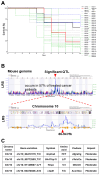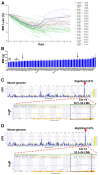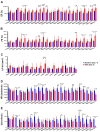This is a preprint.
Unraveling the Genetic Blueprint of Doxorubicin-Induced Cardiotoxicity Through Systems Genetics Approaches
- PMID: 40321772
- PMCID: PMC12047975
- DOI: 10.21203/rs.3.rs-6224399/v1
Unraveling the Genetic Blueprint of Doxorubicin-Induced Cardiotoxicity Through Systems Genetics Approaches
Update in
-
Unraveling the genetic blueprint of doxorubicin-induced cardiotoxicity through systems genetics approaches.Cardiooncology. 2025 Jun 3;11(1):53. doi: 10.1186/s40959-025-00349-y. Cardiooncology. 2025. PMID: 40462234 Free PMC article.
Abstract
Background: Anthracycline-induced cardiotoxicity (ACT) is a significant concern for cancer survivors. The genetic basis of ACT remains unclear because of the impact of lifestyle and environmental factors in human studies. This study employs a murine genetic reference population (GRP) of BXD recombinant inbred strains, derived from DBA/2J (D2) and C57BL/6J (B6) crosses, to map quantitative trait loci (QTLs) linked to doxorubicin (DOX)-induced cardiotoxic phenotypes through systems genetics approaches.
Methods: To model variability in ACT, 58 BXD strains and parental B6 and D2 mice (N ≥ 4 mice/sex, 3-4 months old) underwent an intraperitoneal injection of DOX (20 mg/kg). Survival and body weight (BW) were monitored for 10 days. Echocardiography was performed before treatment and on Day 5 post-treatment. Genetic mapping and Mendelian randomization (MR) analyses were used for identifying QTLs and candidate genes associated with DOX-induced traits and severity.
Results: Parental B6 strain had 60% survival, whereas only 24% of D2 mice survived on Day 10. Among BXD strains, median survival varied, with BXD77 showing the lowest at four days. Echocardiography revealed restrictive dysfunction and a small-heart phenotype resembling "Grinch syndrome" observed in ACT patients. Significant QTLs on Chromosome 10 (86-94 Mb), Chromosome 19 (52.5-54.2 Mb) and on Chromosome 14 (103-120 Mb) were associated with the survival, mean BW loss, and left ventricular (LV) volumes and ejection fraction (EF%), respectively. MR analysis identified significant causal associations between the genes implicated in BW loss (ADD3, HSPA12A, SLC18A2, PDZD8, DUSP5, CASP7) as well as EF% and LV volumes (GPC6, UGGT2, SLAIN1, POU4F1, MBNL2) in BXD mice post-DOX and heart failure (HF) outcomes in humans.
Conclusions: Survival, BW loss, and echocardiography parameters considerably varied among DOX-treated BXDs, suggesting significant influence of genetic background on expression of those traits. Several candidate genes that may modulate ACT susceptibility and HF were identified, providing a foundation for genetic-based risk stratification and therapeutics in cardio-oncology.
Conflict of interest statement
Additional Declarations: No competing interests reported.
Figures





Similar articles
-
Unraveling the genetic blueprint of doxorubicin-induced cardiotoxicity through systems genetics approaches.Cardiooncology. 2025 Jun 3;11(1):53. doi: 10.1186/s40959-025-00349-y. Cardiooncology. 2025. PMID: 40462234 Free PMC article.
-
Echocardiography phenotyping in murine genetic reference population of BXD strains reveals significant QTLs associated with cardiac function and morphology.Physiol Genomics. 2023 Feb 1;55(2):51-66. doi: 10.1152/physiolgenomics.00120.2022. Epub 2022 Dec 19. Physiol Genomics. 2023. PMID: 36534598 Free PMC article.
-
The abundance of cis-acting loci leading to differential allele expression in F1 mice and their relationship to loci harboring genes affecting complex traits.BMC Genomics. 2016 Aug 11;17(1):620. doi: 10.1186/s12864-016-2922-9. BMC Genomics. 2016. PMID: 27515598 Free PMC article.
-
Development of a murine model for aerosolized ebolavirus infection using a panel of recombinant inbred mice.Viruses. 2012 Dec 3;4(12):3468-93. doi: 10.3390/v4123468. Viruses. 2012. PMID: 23207275 Free PMC article. Review.
-
BXD Recombinant Inbred Mice as a Model to Study Neurotoxicity.Biomolecules. 2021 Nov 25;11(12):1762. doi: 10.3390/biom11121762. Biomolecules. 2021. PMID: 34944406 Free PMC article. Review.
References
-
- Miller KD, et al. Cancer treatment and survivorship statistics, 2022. CA Cancer J Clin. 2022;72(5):409–36. - PubMed
-
- DeSantis CE, et al. Cancer treatment and survivorship statistics, 2014. CA Cancer J Clin. 2014;64(4):252–71. - PubMed
-
- Lipshultz SE, et al. Long-term cardiovascular toxicity in children, adolescents, and young adults who receive cancer therapy: pathophysiology, course, monitoring, management, prevention, and research directions: a scientific statement from the American Heart Association. Circulation. 2013;128(17):1927–95. - PubMed
Publication types
Grants and funding
LinkOut - more resources
Full Text Sources
Research Materials
Miscellaneous

